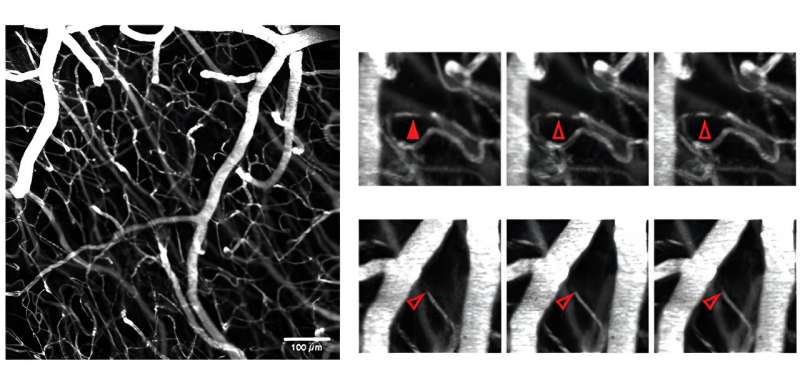This article has been reviewed according to Science X's editorial process and policies. Editors have highlighted the following attributes while ensuring the content's credibility:
fact-checked
trusted source
proofread
New method for detecting blood circulation problems in brain capillaries

The brain is perhaps the most sensitive organ with respect to changes in blood flow and oxygen supply. Even brief interruptions in capillary flow (or "stalling") can indicate acute neurological issues; evidence suggests that chronic conditions like Alzheimer's and Parkinson's diseases are closely related to stalling events. Thus, investigating the effects of stalling could lead to the development of therapies for such disorders.
However, despite tremendous advances in medical imaging over the past few decades, identification of stalling in capillaries remains a formidable challenge. Optical coherence tomography (OCT) is currently the best available method to monitor capillaries within a small volume. But this approach suffers from poor temporal resolution, meaning that it can only capture long stalling events. Also, analyzing data gathered via OCT to determine stalling events requires extensive manual work.
In a recent study published in Neurophotonics, a research team led by Dr. John Giblin from Boston University sought to address these issues. Using a custom setup, the researchers showcased the potential of a technique called Bessel beam two-photon microscopy to obtain volumetric images of brain capillaries. In addition, the team proposed an innovative analysis approach to semi-automate the identification of stalling events.
But what is Bessel beam two-photon microscopy? Two-photon microscopy, a widely used imaging modality, employs laser light to excite fluorescent molecules within a sample. The simultaneous collision of two photons with a fluorescent molecule must occur for light emission, which can greatly reduce background noise. Further, utilizing a Bessel beam, a type of laser beam with a unique intensity distribution that enables it to remain focused in a narrow space over relatively long distances, makes the technique even more promising.
Thanks to this approach, the researchers could obtain clear images of all capillaries within a 713 × 713 × 120 μm3 volume roughly every two seconds. In these images, stalling can be detected in a straightforward manner by focusing on the movement of red blood cells, which appear as shadows. If the cells stay in the same location within a capillary for two or more consecutive frames, it means that the blood flow within the capillary has stalled.
Compared to OCT, the proposed approach using Bessel beam two-photon microscopy could generate images much faster, providing better temporal resolution. However, the larger amount of data produced by this setup only exacerbated the problem of data analysis. Thus, the team came up with a method to make the identification of stalling events easier.
The proposed analysis procedure relies on the fact that the intensity along a stalled capillary in a two-photon image would remain relatively unchanged. The researchers implemented an algorithm to calculate the between-frame intensity correlation for individual capillaries; high correlation implies that the capillary has stalled. By visualizing the calculated correlation instead of the raw intensity image, the researchers found it much easier and quicker to identify stalling events.
The team tested their semi-automated data analysis technique through in vivo experiments on mice to explore the changes in stalling before and after a stroke. The proposed strategy cut the time needed for analysis in half. Moreover, visualizing the intensity correlation proved to be more reliable for detecting stalling than "blind" observation of raw images. Unlike OCT, this imaging strategy was also capable of detecting short stalling events.
Furthermore, Bessel beam two-photon microscopy enables the estimation of the diameter of blood vessels based on fluorescent intensity. To showcase this feature, the researchers investigated the relationship between stalling events and arterial dilations, revealing that enlarged vessels can transiently reduce stalls.
Neurophotonics Associate Editor Ji Yi, a professor of ophthalmology and biomedical engineering at the Johns Hopkins University, remarks, "Taken together, the findings of this study demonstrate the power of Bessel beam two-photon microscopy to explore the intricate workings of the brain's circulatory system and its implications for neurological health." In the near future, fully automated methods to detect stalling will hopefully help scientists investigate, diagnose, and assess the treatment of brain diseases.
More information: John Giblin et al, High throughput detection of capillary stalling events with Bessel beam two-photon microscopy, Neurophotonics (2023). DOI: 10.1117/1.NPh.10.3.035009





















